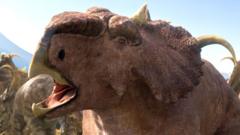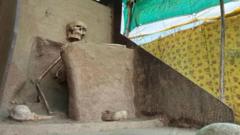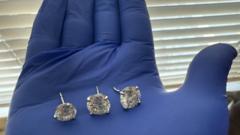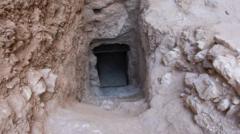A major archaeological find in Pompeii has brought to light an expansive private bathhouse, featuring vibrant art and tragic remnants of its last occupants, amidst ongoing excavations that reveal deeper insights into the lives of Romans before the eruption of Mount Vesuvius.
Spectacular Bathhouse Unearthed in Pompeii: A Glimpse Into Ancient Luxury
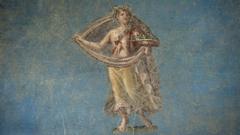
Spectacular Bathhouse Unearthed in Pompeii: A Glimpse Into Ancient Luxury
Archaeologists unearth a stunning private bathhouse in Pompeii, revealing the opulence and tragedy of Roman life.
The ruins of Pompeii, long entombed beneath layers of volcanic ash, have yielded a remarkable discovery described as "once-in-a-century." Archaeologists have uncovered a lavish private bathhouse, which is believed to be among the largest ever found in the ancient Roman city of Pompeii, Italy. This luxurious complex showcases distinct hot, warm, and cold rooms, adorned with exquisite artwork, alongside an impressive plunge pool.
"This find is part of what we're calling the 'Pompeii effect'—it feels like the ancient residents just stepped away moments ago," remarks Dr. Gabriel Zuchtriegel, director of Pompeii's Archaeological Park. The bathing suite, with its vibrant red walls and intricate mosaic flooring, invites visitors to imagine the opulent lifestyle enjoyed by the elite of Pompeii. Analysis of two skeletons found within the bathhouse poignantly illustrates the catastrophe that befell the city during the eruption of Mount Vesuvius in AD 79.
The male skeleton, believed to be a teenager, and a woman aged between 35 and 50 were found huddled in a small room, seeking refuge from the onslaught of superheated ash and gas. The tragic evidence of their final moments evokes a deep emotional connection to the past. "Each artifact and skeleton we find here narrates the story of that day," states Dr. Ludovica Alesse, a Pompeii conservator.
This excavation, hailed as one of the most significant in a generation, has provided a wealth of insights into the daily life of Pompeii's citizens, including a bakery and laundry alongside the private residence, which is believed to have belonged to Aulus Rustius Verus, a high-ranking local politician. The bathhouse itself underscores the elite's luxurious lifestyle, a rarity in Pompeii, as noted by Dr. Zuchtriegel.
"A private bathroom of this scale was strictly reserved for the wealthiest, marking this site as an extraordinary find," he elaborates. Visitors to the complex could enjoy elaborate bathing rituals, transitioning through aesthetically designed rooms leading to a cold plunge, alongside gardens filled with frescoes.
Among the remnants unearthed within the dwelling are a richly decorated banqueting hall, bustling with classical motifs, and a secluded blue prayer room. Meanwhile, stark contrasts of life and death emerge within the findings—such as the juxtaposition of opulence against the grim reality faced by lower-status individuals, as illustrated by the remains intertwined with evidence of servitude in the adjacent, utilitarian spaces.
The excavations have captured global interest, with a BBC documentary team Chronicling the process under the series "Pompeii: The New Dig." As the excavation approaches its conclusion, increased public access to these extraordinary findings is expected. Dr. Anna Onesti, leading the excavation, affirms, "Each day unfolds new surprises, a magical facet of Pompeii's history."
Further exploration into these ancient artifacts continues, fueling interest and drawing attention to the poignant tales of daily life amidst the vibrance and tragedy that define this remarkable archaeological site.
"This find is part of what we're calling the 'Pompeii effect'—it feels like the ancient residents just stepped away moments ago," remarks Dr. Gabriel Zuchtriegel, director of Pompeii's Archaeological Park. The bathing suite, with its vibrant red walls and intricate mosaic flooring, invites visitors to imagine the opulent lifestyle enjoyed by the elite of Pompeii. Analysis of two skeletons found within the bathhouse poignantly illustrates the catastrophe that befell the city during the eruption of Mount Vesuvius in AD 79.
The male skeleton, believed to be a teenager, and a woman aged between 35 and 50 were found huddled in a small room, seeking refuge from the onslaught of superheated ash and gas. The tragic evidence of their final moments evokes a deep emotional connection to the past. "Each artifact and skeleton we find here narrates the story of that day," states Dr. Ludovica Alesse, a Pompeii conservator.
This excavation, hailed as one of the most significant in a generation, has provided a wealth of insights into the daily life of Pompeii's citizens, including a bakery and laundry alongside the private residence, which is believed to have belonged to Aulus Rustius Verus, a high-ranking local politician. The bathhouse itself underscores the elite's luxurious lifestyle, a rarity in Pompeii, as noted by Dr. Zuchtriegel.
"A private bathroom of this scale was strictly reserved for the wealthiest, marking this site as an extraordinary find," he elaborates. Visitors to the complex could enjoy elaborate bathing rituals, transitioning through aesthetically designed rooms leading to a cold plunge, alongside gardens filled with frescoes.
Among the remnants unearthed within the dwelling are a richly decorated banqueting hall, bustling with classical motifs, and a secluded blue prayer room. Meanwhile, stark contrasts of life and death emerge within the findings—such as the juxtaposition of opulence against the grim reality faced by lower-status individuals, as illustrated by the remains intertwined with evidence of servitude in the adjacent, utilitarian spaces.
The excavations have captured global interest, with a BBC documentary team Chronicling the process under the series "Pompeii: The New Dig." As the excavation approaches its conclusion, increased public access to these extraordinary findings is expected. Dr. Anna Onesti, leading the excavation, affirms, "Each day unfolds new surprises, a magical facet of Pompeii's history."
Further exploration into these ancient artifacts continues, fueling interest and drawing attention to the poignant tales of daily life amidst the vibrance and tragedy that define this remarkable archaeological site.



